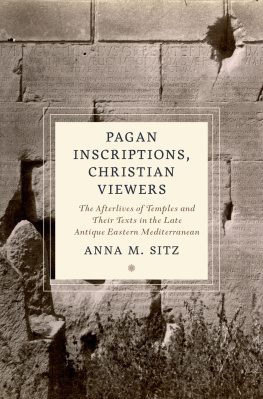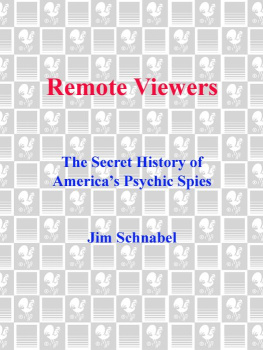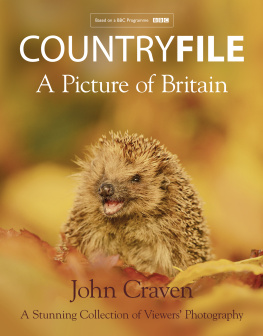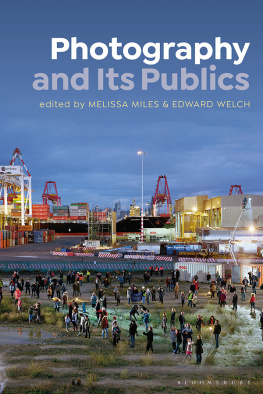MAKING
PHOTOGRAPHY
MATTER
MAKING
PHOTOGRAPHY
MATTER
A VIEWERS HISTORY FROM THE
CIVIL WAR TO THE GREAT DEPRESSION
CARA A. FINNEGAN
UNIVERSITY OF ILLINOIS PRESS
Urbana, Chicago, and Springfield
2015 by the Board of Trustees of the University of Illinois
All rights reserved
Manufactured in the United States of America
c 5 4 3 2 1
 This book is printed on acid-free paper.
This book is printed on acid-free paper.
Library of Congress Cataloging-in-Publication Data
Finnegan, Cara A.
Making photography matter : a viewers history from the Civil War to the Great Depression /
Cara A. Finnegan.
pages cm
Includes bibliographical references and index.
ISBN 978-0-252-03926-3 (hardcover : alk. paper)
ISBN 978-0-252-09731-7 (e-book)
1. Documentary photographyUnited StatesHistory20th century. 2. Documentary photographyUnited StatesHistory19th century. 3. PhotographySocial aspectsUnited States. I. Title.
TR23.F548 2015
770.9034dc23 2014045920
For all of my teachers, with gratitude
Contents
Illustrations
Acknowledgments
In the late stages of this project, I was diagnosed with a pretty serious illness. In the TV movie version of this story, the shocked and chastened workaholic realizes the error of her ways, acknowledges that she has misdirected her best years by focusing too much on her job, takes up yoga, escapes death, and discovers what really matters. Now, I am all for yoga, and escaping death is great, but I have to confess that this was not my experience. The need to temporarily set aside my work in order to attend to my health produced the opposite response: I couldnt wait to get back to work. Not only because I love my work, but also because the people with whom I work are phenomenal human beings. My cancer experience reinforced something I had always known intellectually but had never before felt so viscerally: that I have amazing friends and colleagues near and far, people who care not only about the life of the mind but about the life in the rest of me, too. For that reason and for so many others, this is a long list of acknowledgments.
At the University of Illinois Press, Kendra Boileau saw potential in the original project and extended an advance contract. Danny Nasset helped me navigate reviews and bring the book to completion. He also patiently waited when illness delayed my work for nearly a year. Many thanks also to the smart and efficient production and marketing staff at the press, including Marika Christofides, Tad Ringo, Jennifer Holzner, and Jill R. Hughes. Thanks to Amy Murphy for a detailed, efficient index. Two anonymous reviewers engaged deeply with two drafts of the manuscript, identifying its weaknesses and helping me to build upon its strengths. I am immensely grateful for their insistence that I keep pushing to make this project better. A huge thanks also to Dennis Sears of the University of Illinois Rare Book and Manuscript Library, who saved the day in the midst of a big image emergency.
This book more or less became a coherent project during a 20062007 sabbatical year as the William S. Vaughn Visiting Fellow at Vanderbilt Universitys Robert Penn Warren Center for the Humanities. My year in Nashville was, to put it simply, divine. Center director Mona Frederick and my colleagues in the Between Word and Image fellows group offered valuable engagement with the earliest versions of the ideas in this book. Many thanks to my fellow fellows Carolyn Dever, Gregg Horowitz, Teresa Goddu, Robin Jensen, Kevin Leander, Ellen Levy, Richard McGregor, Catherine Molineux, and Paul Young. Beloved friends Bonnie Dow and John Sloopamazing scholars, bothwelcomed me and always made sure I ate and drank well.
The University of Illinois supported this project with an Arnold O. Beckman Award from the Campus Research Board; recurring Humanities, Arts, and Social Sciences (HASS) funding; and discretionary funds associated with my appointment as a Conrad Humanities Professorial Scholar. I am grateful for the universitys ongoing commitment to humanities research. In the Department of Communication the leadership of Barb Wilson, the late Dale Brashers, Dave Tewksbury, and John Caughlin has always modeled the best of what we like to call the Illinois way: work hard and care about each other. During much of the period I was writing this book, I held administrative appointments in the department, first as a course director and most recently as director of graduate studies. Many thanks to Grace Giorgio, the staff of CMN 111112, and the incomparable Mary Strum for helping me keep those trains running on time. I also had the great fortune to have multiple generations of research assistants work with me on this project, including George Boone, Courtney Caudle Travers, Troy Cooper, Kassie Lamp, Daniel Larson, Marissa Lowe Wallace, Sabrina Marsh, Julius Riles, and Jillian Klean-Zwilling. Many thanks to each of them.
I presented earlier versions of these ideas on the University of Illinois campus at the Center for Writing Studies, the Lincoln and Cultural Value symposium, and the Modern Art Colloquium. Off campus I received invitations to share my work with colleagues and students at Penn State, University of WisconsinMadison, Carnegie Mellon University, Northwestern University, University of Texas, University of Georgia, and University of Alabama. I also presented parts of the project at conferences at Syracuse University, University of Pittsburgh, Indiana University, Rochester Institute of Technology, the Alta Conference on Argumentation, and the Rhetoric Society of America. I thank Anne Demo, Diane Hope, Rosa Eberly, Dana Cloud, Janis Edwards, Christa Olson, Gordon Hutner, Terri Weissman, Lester Olson, Robert Hariman, and James Wynn for these invitations and for many productive conversations. Parts of chapter two appeared in a 2005 Rhetoric & Public Affairs essay and an early version of chapter three appeared in a 2009 piece in POROI. Thanks to editors Martin Medhurst and John Nelson for guidance on those earlier publications. Other colleagues who shared their insights and friendship include John Murphy, Debbie Hawhee, Vanessa Beasley, John Lucaites, Ned OGorman, Michael Shaw, Jenny Greenhill, Rachael DeLue, Jordana Mendelson, Nancy Abelmann, Jenny Rice, Amy Young, James Jasinski, Jennifer Mercieca, Rob Asen, Chuck Morris, Dan Brouwer, Jim Aune, Ray McKerrow, Brad Vivian, Grace Giorgio, Greg Goodale, Tom Goodnight, Vincent Pham, Robin Jensen, Jiyeon Kang, Jennifer Jones-Barbour, Kassie Lamp, David Cisneros, Jeremy Engels, Stephen Hartnett, Sue Zaeske, David Zarefsky, Kirt Wilson, and Michael Leff.
My spouse, John Murphy, came into my life at just the moment when I needed love and joy and dogs and cats. This outstanding colleague and critics fingerprints are all over this manuscript in ways that made it so much better. If life really is a marathon, John Murphy, then I am grateful to be running this stretch of it alongside you.
The spirit of my doctoral advisor, Tom Farrell, hovers over this book. Although Tom died before we were able to have any meaningful conversations about the project, his ideas about what rhetoric is and how it works continue to inform and inspire me. If anyone would enjoy a project that spans the rhetorical spectrum from war, death, and poverty to ghosts, family pictures, and P. T. Barnum, it would be most certainly be Tom.










 This book is printed on acid-free paper.
This book is printed on acid-free paper.